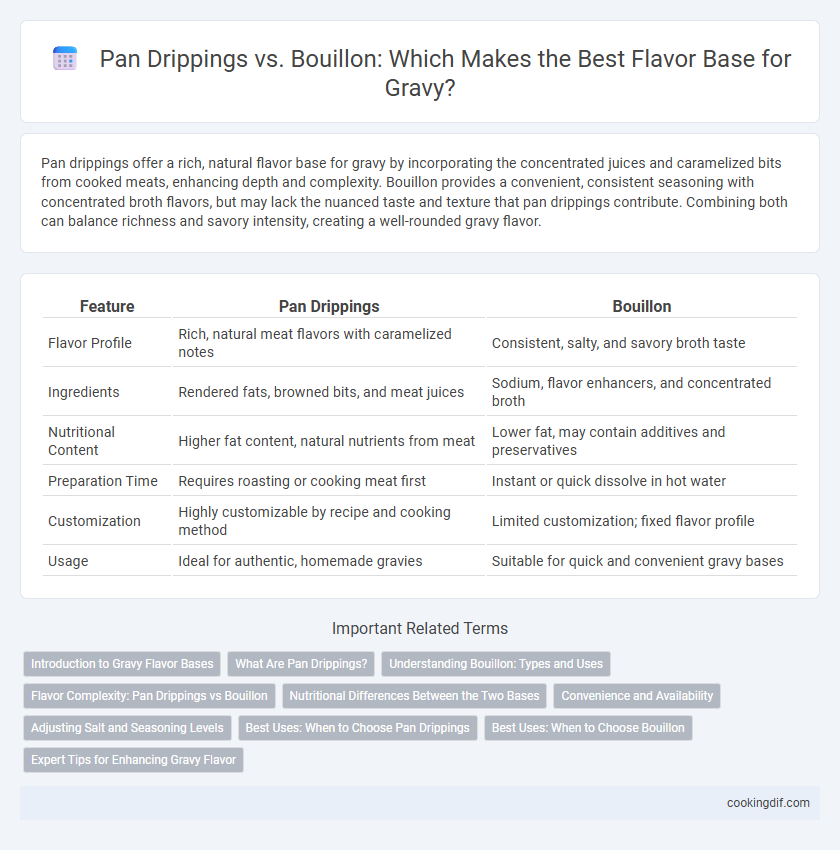Pan drippings offer a rich, natural flavor base for gravy by incorporating the concentrated juices and caramelized bits from cooked meats, enhancing depth and complexity. Bouillon provides a convenient, consistent seasoning with concentrated broth flavors, but may lack the nuanced taste and texture that pan drippings contribute. Combining both can balance richness and savory intensity, creating a well-rounded gravy flavor.
Table of Comparison
| Feature | Pan Drippings | Bouillon |
|---|---|---|
| Flavor Profile | Rich, natural meat flavors with caramelized notes | Consistent, salty, and savory broth taste |
| Ingredients | Rendered fats, browned bits, and meat juices | Sodium, flavor enhancers, and concentrated broth |
| Nutritional Content | Higher fat content, natural nutrients from meat | Lower fat, may contain additives and preservatives |
| Preparation Time | Requires roasting or cooking meat first | Instant or quick dissolve in hot water |
| Customization | Highly customizable by recipe and cooking method | Limited customization; fixed flavor profile |
| Usage | Ideal for authentic, homemade gravies | Suitable for quick and convenient gravy bases |
Introduction to Gravy Flavor Bases
Pan drippings provide a rich, natural depth of flavor for gravy by incorporating the caramelized bits and fats from cooked meats, enhancing umami and complexity. Bouillon offers a convenient, concentrated flavor base often made from dehydrated broth, meat extracts, and seasoning, delivering consistent taste with less effort. Combining pan drippings with bouillon can create a balanced gravy that maximizes savory notes while maintaining ease of preparation.
What Are Pan Drippings?
Pan drippings are the flavorful juices and browned bits left in a pan after cooking meat, containing concentrated fats, caramelized proteins, and seasonings that form the foundation of rich, savory gravies. Unlike bouillon, which is a pre-made stock or seasoning cube, pan drippings provide a natural depth of flavor and umami directly from the cooked ingredients, enhancing the complexity of the gravy. Utilizing pan drippings as a flavor base maximizes taste by incorporating the meat's essence, making it an essential element for traditional, homemade gravies.
Understanding Bouillon: Types and Uses
Bouillon is a concentrated flavor base made from simmered meat, vegetables, and herbs, available in forms such as cubes, powders, and liquids, enhancing gravies with rich, consistent taste. Unlike pan drippings, which provide natural fats and sugars from roasted meats, bouillon offers versatile seasoning without the variability of roasted residue. Chefs often incorporate bouillon to deepen the umami profile and balance saltiness in gravies, especially when pan drippings are sparse or unavailable.
Flavor Complexity: Pan Drippings vs Bouillon
Pan drippings offer a rich, savory flavor base with natural caramelized notes and depth from roasted meat juices, creating a complex taste profile in gravy. Bouillon provides a consistent, concentrated broth flavor, often enhanced with herbs and seasonings, but lacks the nuanced, layered character found in pan drippings. Using pan drippings results in a more robust and authentic gravy, while bouillon delivers convenience and uniformity in flavor.
Nutritional Differences Between the Two Bases
Pan drippings contain concentrated fats, proteins, and minerals extracted directly from cooked meat, contributing essential amino acids and higher calorie content to gravies, while bouillon typically offers lower calories and sodium content but lacks the rich protein and fat profile found in pan drippings. Bouillon cubes or powders are often fortified with sodium and flavor enhancers, making them less nutrient-dense compared to natural pan drippings, which provide micronutrients like iron and zinc. Choosing pan drippings enhances the gravy's nutritional value by adding bioavailable nutrients, whereas bouillon primarily influences taste with minimal contribution to overall nutrition.
Convenience and Availability
Pan drippings provide a rich, natural flavor directly from roasted meats, making them a convenient and flavorful base when available immediately after cooking. Bouillon offers consistent availability and ease of use, stored in powdered, granulated, or cube form, allowing quick preparation without the need for fresh pan juices. For busy kitchens, bouillon ensures flavor readiness anytime, while pan drippings deliver superior depth when accessible.
Adjusting Salt and Seasoning Levels
Pan drippings provide a rich, naturally seasoned base for gravy, often requiring less added salt due to their concentrated savory flavors. Bouillon can offer consistent seasoning but tends to be saltier, necessitating careful adjustment to avoid over-seasoning. Balancing salt and additional seasonings ensures a perfect gravy flavor, whether using pan drippings or bouillon as the base.
Best Uses: When to Choose Pan Drippings
Pan drippings provide a rich, natural depth of flavor ideal for gravies accompanying roasted meats such as beef, turkey, or chicken. Their concentrated taste captures the essence of the roasted protein, enhancing dishes where authenticity and intensity are paramount. Choose pan drippings when a savory, homemade flavor base is desired, especially in traditional roasting and holiday meals.
Best Uses: When to Choose Bouillon
Bouillon is best chosen for enhancing gravies when a consistent and concentrated flavor base is needed without the variability of pan drippings, especially in recipes requiring quick preparation or when roasting juices are unavailable. It provides a balanced, savory depth ideal for vegetarian or low-fat gravies, or when scaling up recipes for large batches where flavor uniformity is essential. Bouillon cubes or powders dissolve easily, making them perfect for creating rich, flavorful gravies in a controlled and convenient manner.
Expert Tips for Enhancing Gravy Flavor
Pan drippings offer a rich, concentrated flavor infused with caramelized meat juices, providing an authentic depth to gravy. Bouillon cubes or stock serve as a versatile base with consistent saltiness and seasoning, allowing customizable intensity and moisture. Expert chefs recommend combining pan drippings with a high-quality bouillon or stock to balance robust meaty notes and enhance overall umami complexity.
Pan drippings vs bouillon for flavor base Infographic

 cookingdif.com
cookingdif.com